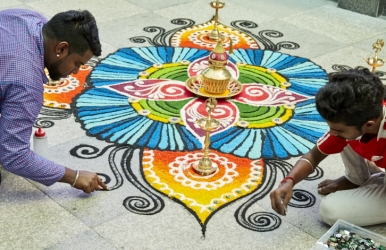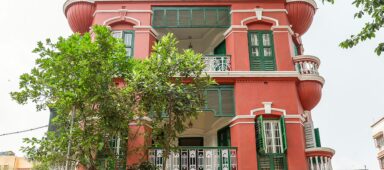Kolam, the ancient Indian rice art form, is full of symbolism and artistry

Kneeling on the floor, Ruben Prakash scoops up a handful of bright pink rice grains that he had dyed the night before and sprinkles them on the courtyard of the Sri Muthu Mariamman temple.The 31-year-old artist is making kolam, an ancient Indian rice art form typically drawn on the doorstep of homes to welcome auspicious occasions, and traditionally done with rice grains in order to feed ants and small birds.

In South India, kolams are identified by motifs marked on a grid of equidistant dots, curves and lines. In the north, where artists like Ruben take their inspirations, kolam is expressed with bright vibrant colours and known as the rangoli style. Traditionally, kolam artists are women, but of late, there is a rising tide of male artists who have taken up this artform as well.
It’s not hard to see the appeal of kolam to an artist who loves a good challenge: entirely freehand, the process not only demands artistic imagination, but exceptional motor skills. Sometimes, Ruben curves his palm like an icing cone to pipe coloured rice grains forming perfectly proportioned stripes. On other occasions, he uses an ordinary squeeze bottle like a pen to draw precisely shaped curls.

“You notice I never talk when I'm doing a painting,” he says. “To achieve this level of technical accuracy, I must have full concentration. To me, doing kolam art is like meditation.”
Three hours of knee-punishing labour later, Ruben’s dhoti (long men’s tunic) is soaked in sweat. Featuring mandala symbols, peacock feathers, petals, and embellished with oil lamps and beadwork, his completed work is unmistakably religious yet beautifully artistic in its execution. The bold colours, strong symbolism and confident lines give it a 3D life-likeness. “I want people to not just see but feel the movement,” Ruben says earnestly.
Watching him at work is impressive, but his life story is just as extraordinary.

Ruben came from a broken family, and at nine years old, was sent to an orphanage run by Pure Life Society, an NGO that runs a home and school for underprivileged children and displaced families. There, he discovered not only his calling for art, but kind Samaritans who nurtured his talent. Every festive season, donors would give presents to the children. Without fail, Ruben would ask for colours: Buncho, Luna, he knew all the good brands. As he got older, he got another boost in his blossoming career when his matron, Madam Pushpa Jeyasingam, invited an art teacher from India who taught the children at the orphanage how to draw kolam. One of them was Ruben.
Since then, he has passionately developed his skills in the art by studying the works of great kolam teachers. He did the Society proud by winning a scholarship for a degree in Professional Design and Visual Communications from Limkokwing University of Creative Technology, the first Indian to do so. After graduation, he joined the university as a staff; four learning-rich years taught him about using tonality in his work, a technique that eventually became his signature.
Ruben went full-time as a kolam artist in 2011, and won his big break in 2014 when he successfully pitched to do a piece for Mid Valley Megamall. The biggest kolam artwork ever in the country then at 18.3 metres long (a record that will be broken this month when his latest artwork measuring 44.2 metres long is unveiled in Malaysia’s low-cost carrier terminal, klia2), the feat received wide media coverage. From then on, he graduated from being a small-time freelancer to a highly sought-after collaborator for corporations.

Having distinguished himself as a kolam artist extraordinaire, Ruben hopes to start a school for underprivileged children to teach Indian visual arts such as kolam, embroidery and traditional Indian makeup. “If children are given a tool, they can stand on their own two feet. I was given that opportunity at a young age by Pure Life Society and the best way to thank them is to pay it forward.”





